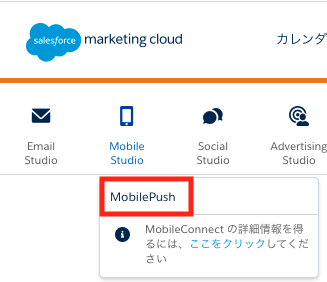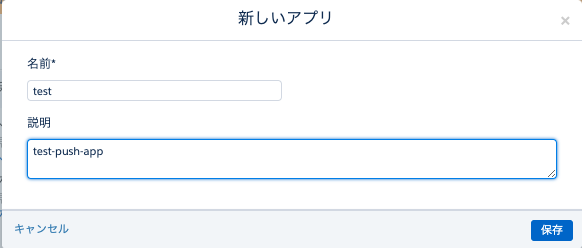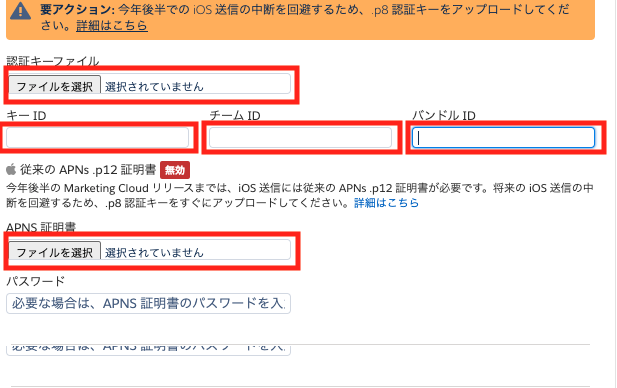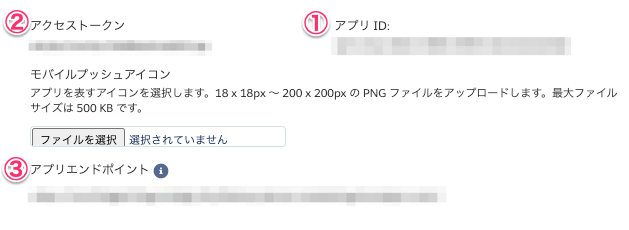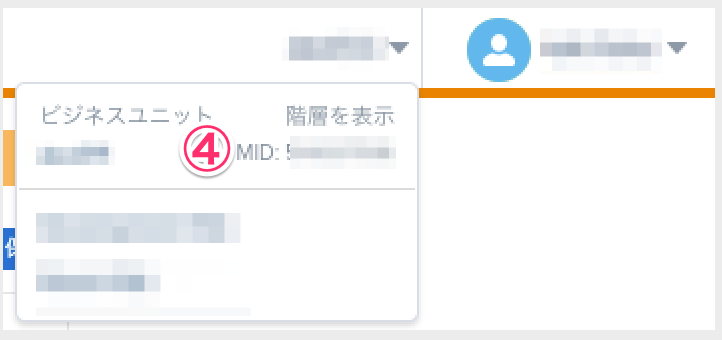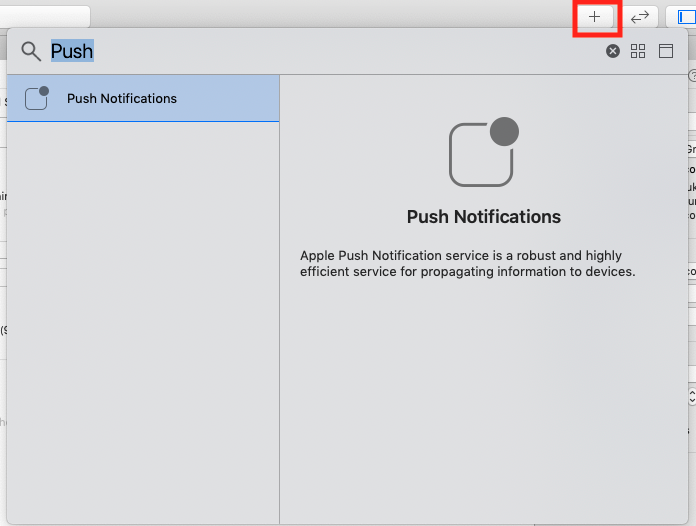環境
・xcode Version 11.3.1 (11C504)
・swift Version 5.1.3
・MarketingCloudSDK iOS (v7.2.1)
・Mac OS 10.14.6(Mojave)
準備
・APNs用証明書(.p12)
・認証キー(.p8)
※2020/08/04段階では両方取得する必要がある。(多分そのうち.p8認証キーだけでいけるっぽい)
参考リンク
.p12
https://qiita.com/natsumo/items/d5cc1d0be427ca3af1cb
.p8
https://docs.repro.io/ja/dev/sdk/push-notification/setup-ios.html#app-id
SMCのMobilePushでアプリを作成する
- mobilePushを選択する
3.新しいアプリの作成を選択する
4.わかりやすい名前と説明を記載する
5.作成した認証キーファイル、APNS証明書を選択する
キーID:認証キー(.P8)をダウンロードする際に表示されるKey ID
チームID:Apple Developer ProgramのチームID
バンドルID:Apple Developer Programでアプリを登録する際に記述したBundle ID
6.保存後に有効になっているか確認
SDKを追加
CocoaPodsを利用してSDKを追加する
1.プロジェクト名.xcodeproj」と同じディレクトリにターミナル上で移動する
$cd [指定ディレクトリ]
2.CocoaPodsをインストールする
sudo gem install cocoapods
※すでにインストールしている場合
$ sudo gem update --system
3.セットアップする
pod setup
4.バージョンを確認する
$ pod --version
バージョンが表示されればインストールされている
5.Podfile(どのライブラリをインストールするか指定するファイル)を作成する
$ pod init
6.作成したpodfileに以下の内容を記述する
target 'MyApp' do
pod 'MarketingCloudSDK', '~> 7.2'
end
7.workspaceを作成する
$ pod install --no-repo-update
作成された「プロジェクト名.xcworkspace」をダブルクリックしてXcodeを開く
※.xcodeprojではなく.xcworkspaceを開く
SDKの初期設定を記述
// 導入したSDKをインポート
import MarketingCloudSDK
class AppDelegate: UIResponder, UIApplicationDelegate {
var window: UIWindow?
// MobilePush SDK: REQUIRED IMPLEMENTATION
// The appID, accessToken and appEndpoint are required values for MobilePush SDK configuration and are obtained from your MobilePush app.
// See https://salesforce-marketingcloud.github.io/MarketingCloudSDK-iOS/get-started/get-started-setupapps.html for more information.
// Use the builder method to configure the SDK for usage. This gives you the maximum flexibility in SDK configuration.
// The builder lets you configure the SDK parameters at runtime.
#if DEBUG
// 下記キャプチャ①参考
let appID = "[DEV-APNS App ID value from MobilePush app admin]"
// 下記キャプチャ②参考
let accessToken = "[DEV-APNS Access Token value from MobilePush app admin]"
// 下記キャプチャ③参考
let appEndpoint = "[DEV-APNS App Endpoint value from MobilePush app admin]"
// 下記キャプチャ④参考
let mid = "[DEV-APNS account MID value from MobilePush app admin]"
#else
// 以下上と同じ
let appId = "[PROD-APNS appId value from MobilePush app admin]"
let accessToken = "[PROD-APNS accessToken value from MobilePush app admin]"
let appEndpoint = "[PROD-APNS app endpoint value from MobilePush app admin]"
let mid = "[PROD-APNS account MID value from MobilePush app admin]"
#endif
// Define features of MobilePush your app will use.
// 必要に応じてtrueに変更する
let inbox = false // 受信トレイ
let location = false // 位置情報
let analytics = true // SMCの分析機能
// MobilePush SDK: REQUIRED IMPLEMENTATION
@discardableResult
func configureMarketingCloudSDK() -> Bool {
// Use the builder method to configure the SDK for usage. This gives you the maximum flexibility in SDK configuration.
// The builder lets you configure the SDK parameters at runtime.
// パラメータをセット(コンタクトキーが設定されるまで登録を遅らせることが可能)
let builder = MarketingCloudSDKConfigBuilder()
.sfmc_setApplicationId(appID)
.sfmc_setAccessToken(accessToken)
.sfmc_setMarketingCloudServerUrl(appEndpoint)
.sfmc_setMid(mid)
.sfmc_setInboxEnabled(inbox as NSNumber)
.sfmc_setLocationEnabled(location as NSNumber)
.sfmc_setAnalyticsEnabled(analytics as NSNumber)
.sfmc_build()!
var success = false
// Once you've created the builder, pass it to the sfmc_configure method.
do {
try MarketingCloudSDK.sharedInstance().sfmc_configure(with:builder)
// ユーザ情報をSMCに登録できる
MarketingCloudSDK.sharedInstance().sfmc_setContactKey("test12345")
// ユーザの属性をSMCに登録できる
MarketingCloudSDK.sharedInstance().sfmc_setAttributeNamed("test_id", value: "12345678")
success = true
} catch let error as NSError {
// Errors returned from configuration will be in the NSError parameter and can be used to determine
// if you've implemented the SDK correctly.
let configErrorString = String(format: "MarketingCloudSDK sfmc_configure failed with error = %@", error)
print(configErrorString)
}
if success == true {
// The SDK has been fully configured and is ready for use!
// Enable logging for debugging. Not recommended for production apps, as significant data
// about MobilePush will be logged to the console.
#if DEBUG
// trueにしておくとxcodeのコンソール上でデバッグできる
MarketingCloudSDK.sharedInstance().sfmc_setDebugLoggingEnabled(true)
#endif
// Set the MarketingCloudSDKURLHandlingDelegate to a class adhering to the protocol.
// In this example, the AppDelegate class adheres to the protocol
// and handles URLs passed back from the SDK.
// For more information, see https://salesforce-marketingcloud.github.io/MarketingCloudSDK-iOS/sdk-implementation/implementation-urlhandling.html
// opendirect機能に必要(Extensionでプロトコルを追加する必要あり)
MarketingCloudSDK.sharedInstance().sfmc_setURLHandlingDelegate(self)
// Make sure to dispatch this to the main thread, as UNUserNotificationCenter will present UI.
DispatchQueue.main.async {
if #available(iOS 10.0, *) {
// Set the UNUserNotificationCenterDelegate to a class adhering to thie protocol.
// In this exmple, the AppDelegate class adheres to the protocol (see below)
// and handles Notification Center delegate methods from iOS.
UNUserNotificationCenter.current().delegate = self
// Request authorization from the user for push notification alerts.
UNUserNotificationCenter.current().requestAuthorization(options: [.alert, .sound, .badge], completionHandler: {(_ granted: Bool, _ error: Error?) -> Void in
if error == nil {
if granted == true {
// Your application may want to do something specific if the user has granted authorization
// for the notification types specified; it would be done here.
print(MarketingCloudSDK.sharedInstance().sfmc_deviceToken() ?? "error: no token - was UIApplication.shared.registerForRemoteNotifications() called?")
}
}
})
}
// In any case, your application should register for remote notifications *each time* your application
// launches to ensure that the push token used by MobilePush (for silent push) is updated if necessary.
// Registering in this manner does *not* mean that a user will see a notification - it only means
// that the application will receive a unique push token from iOS
// ここでデバイストークンをSMC側に渡すメソッドを呼ぶ
UIApplication.shared.registerForRemoteNotifications()
}
}
return success
}
// MobilePush SDK: REQUIRED IMPLEMENTATION
func application(_ application: UIApplication, didFinishLaunchingWithOptions launchOptions: [UIApplication.LaunchOptionsKey: Any]?) -> Bool {
return self.configureMarketingCloudSDK()
}
// MobilePush SDK: OPTIONAL IMPLEMENTATION (if using Data Protection)
func applicationProtectedDataDidBecomeAvailable(_ application: UIApplication) {
if(MarketingCloudSDK.sharedInstance().sfmc_isReady() == false)
{
self.configureMarketingCloudSDK()
}
}
}
Push通知実装
- xcodeのcapabilityからPush Notificationsを有効にする
2.push通知のために必要なUIApplicationDelegateメソッドをAppDelegateクラスに追加(必要に応じて拡張する)
// MobilePush SDK: REQUIRED IMPLEMENTATION
// アプリを最初にタップして、起動した時に呼ばれるメソッド
func application(_ application: UIApplication, didFinishLaunchingWithOptions launchOptions: [UIApplication.LaunchOptionsKey: Any]?) -> Bool {
return self.configureMarketingCloudSDK()
}
// MobilePush SDK: REQUIRED IMPLEMENTATION
// registerForRemoteNotifications()が呼ばれると下記のメソッドが呼ばれ、引数としてデバイストークンをSDKに渡す。
func application(_ application: UIApplication, didRegisterForRemoteNotificationsWithDeviceToken deviceToken: Data) {
MarketingCloudSDK.sharedInstance().sfmc_setDeviceToken(deviceToken)
}
// MobilePush SDK: REQUIRED IMPLEMENTATION
func application(_ application: UIApplication, didFailToRegisterForRemoteNotificationsWithError error: Error) {
print(error)
}
// MobilePush SDK: REQUIRED IMPLEMENTATION
if this method is implemented. **/
// アプリ未起動時、バックグラウンド時に通知をタップすると呼び出される。フォアグラウンド時は通知表示はないが呼び出される。
func application(_ application: UIApplication, didReceiveRemoteNotification userInfo: [AnyHashable : Any], fetchCompletionHandler completionHandler: @escaping (UIBackgroundFetchResult) -> Void) {
MarketingCloudSDK.sharedInstance().sfmc_setNotificationUserInfo(userInfo)
completionHandler(.newData)
}
3.push通知のために必要なUNUserNotificationCenterDelegate メソッドをAppDelegateクラスに追加
// MobilePush SDK: REQUIRED IMPLEMENTATION
// The method will be called on the delegate when the user responded to the notification by opening the application, dismissing the notification or choosing a UNNotificationAction. The delegate must be set before the application returns from applicationDidFinishLaunching:.
// このメソッドでSMCから受け取ったカスタムキーを取得したりする
extension AppDelegate: UNUserNotificationCenterDelegate {
@available(iOS 10.0, *)
func userNotificationCenter(_ center: UNUserNotificationCenter, didReceive response: UNNotificationResponse,
withCompletionHandler completionHandler: @escaping () -> Void) {
// Required: tell the MarketingCloudSDK about the notification. This will collect MobilePush analytics
// and process the notification on behalf of your application.
MarketingCloudSDK.sharedInstance().sfmc_setNotificationRequest(response.notification.request)
completionHandler()
}
// MobilePush SDK: REQUIRED IMPLEMENTATION
// The method will be called on the delegate only if the application is in the foreground. If the method is not implemented or the handler is not called in a timely manner then the notification will not be presented. The application can choose to have the notification presented as a sound, badge, alert and/or in the notification list. This decision should be based on whether the information in the notification is otherwise visible to the user.
@available(iOS 10.0, *)
func userNotificationCenter(_ center: UNUserNotificationCenter, willPresent notification: UNNotification,
withCompletionHandler completionHandler: @escaping (UNNotificationPresentationOptions) -> Void) {
completionHandler(.alert)
}
}
SMCからpush通知を送信する
アプリ起動時にpush通知を許可にし、無事とどけばOK
参考リンク(公式)
